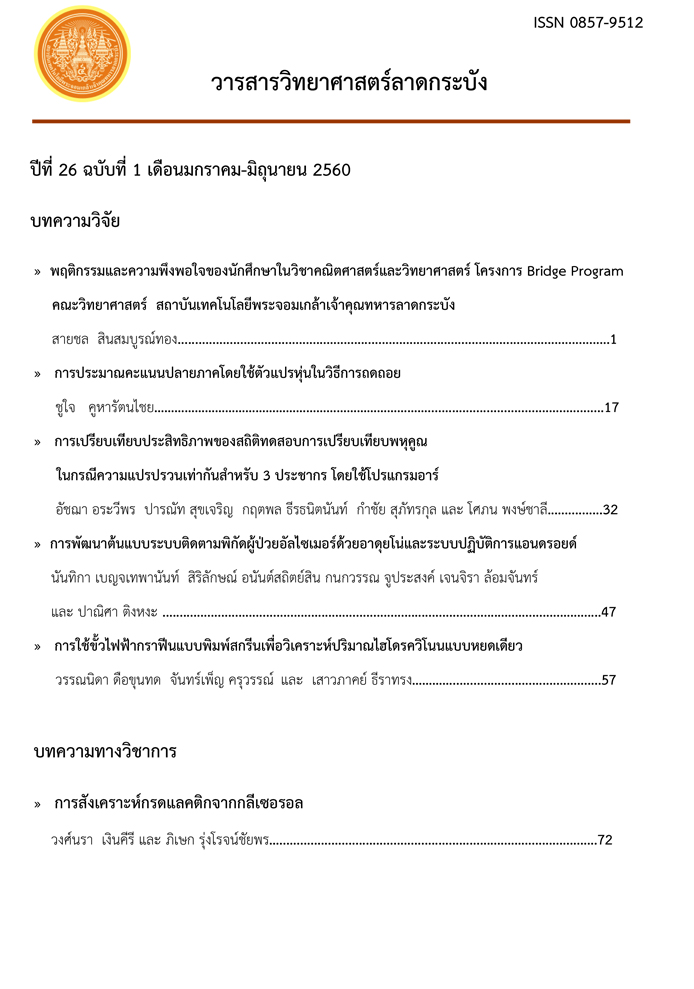พฤติกรรมและความพึงพอใจของนักศึกษาในวิชาคณิตศาสตร์และวิทยาศาสตร์ โครงการ Bridge Program คณะวิทยาศาสตร์ สถาบันเทคโนโลยีพระจอมเกล้าเจ้าคุณทหารลาดกระบัง
Main Article Content
Abstract
ในการศึกษาเรื่องพฤติกรรมและความพึงพอใจของนักศึกษาในวิชาคณิตศาสตร์และวิทยาศาสตร์
โครงการ Bridge program คณะวิทยาศาสตร์ สถาบันเทคโนโลยีพระจอมเกล้าเจ้าคุณทหารลาดกระบัง
จากทุกสาขาวิชาและทุกหลักสูตร ในชั้นปีที่ 1 ปีการศึกษา 2559 โดยใช้แบบสอบถามซึ่งประกอบด้วย
สถานภาพส่วนตัว พฤติกรรมในการเรียนของนักศึกษาและความพึงพอใจในการสอนของอาจารย์ในวิชา
คณิตศาสตร์และวิทยาศาสตร์ โดยสุ่มตัวอย่างแบบแบ่งชั้นภูมิชนิดสุ่มอย่างง่าย ใช้การทดสอบความเป็น
เอกภาพของสัดส่วน และหาข้อสรุปเกี่ยวกับผลผลสัมฤทธิ์ทางการเรียนโดยการทดสอบค่าเฉลี่ยของ
ประชากร 2 กลุ่ม ที่ไม่เป็นอิสระกัน ทําการวิเคราะห์ข้อมูลด้วยโปรแกรมสําเร็จรูป SPSS version 22
ผลของการวิจัยพบว่าสัดส่วนของพฤติกรรมในการเรียนของนักศึกษาในด้านต่าง ๆ สําหรับหลักสูตรที่เรียนมี
ความแตกต่างกันค่อนข้างมาก และสัดส่วนของพฤติกรรมในการเรียนของนักศึกษาในด้านต่าง ๆ สําหรับ
สาขาวิชาที่เรียนมีความแตกต่างกันพอสมควร ยังพบอีกว่าสัดส่วนของความพึงพอใจในการสอนของอาจารย์
ในด้านต่าง ๆ สําหรับหลักสูตรที่เรียนมีความแตกต่างกันค่อนข้างมาก และสัดส่วนของความพึงพอใจในการ
สอนของอาจารย์ในด้านต่าง ๆ สําหรับเพศและสาขาวิชาที่เรียนมีความแตกต่างกันพอสมควร นักศึกษาทุก
หลักสูตรมีคะแนนสอบเฉลี่ยก่อนเรียนน้อยกว่าหลังเรียนอย่างมีนัยสําคัญทางสถิติ โดยนักศึกษาในหลักสูตร
เคมีอุตสาหกรรมมีคะแนนเฉลี่ยก่อนเรียน 35.26 หลังเรียน 39.54 จากคะแนนเต็ม 100 คะแนน ค่า t =
-5.07 และ p-value = 0.000 เคมีสิ่งแวดล้อมมีคะแนนเฉลี่ยก่อนเรียน 29.87 หลังเรียน 33.24 คะแนน
ค่า t = -3.58 และ p-value = 0.000 จุลชีววิทยามีคะแนนเฉลี่ยก่อนเรียน 28.95 หลังเรียน 32.59
คะแนน ค่า t = -2.38 และ p-value = 0.013 เทคโนโลยีชีวภาพมีคะแนนเฉลี่ยก่อนเรียน 29.76
หลังเรียน 38.59 คะแนน ค่า t = -4.14 และ p-value = 0.000 ฟิสิกส์ประยุกต์มีคะแนนเฉลี่ย ก่อนเรียน 28.05 หลังเรียน 33.75 คะแนน ค่า t = -3.22 และ p-value = 0.002 คณิตศาสตร์ประยุกต์มี
คะแนนเฉลี่ยก่อนเรียน 31.78 หลังเรียน 38.26 คะแนน ค่า t = -4.63 และ p-value = 0.000 วิทยาการ
คอมพิวเตอร์มีคะแนนเฉลี่ยก่อนเรียน 39.40 หลังเรียน 44.90 คะแนน ค่า t = -3.64 และ p-value =
0.001 และสถิติประยุกต์มีคะแนนเฉลี่ยก่อนเรียน 30.76 หลังเรียน 33.49 คะแนน ค่า t = -2.36 และ pvalue = 0.012 ดังนั้นการที่นักศึกษาทุกหลักสูตรได้เรียนโครงการ Bridge program ทําให้นักศึกษาทํา
คะแนนสอบเฉลี่ยหลังเรียนได้มากกว่าก่อนเรียนแตกต่างกันอย่างมีนัยสําคัญทางสถิติที่ระดับนัยสําคัญ 0.05
คําสําคัญ : พฤติกรรม ความพึงพอใจ การสุ่มตัวอย่างแบบแบ่งชั้นภูมิชนิดสุ่มอย่างง่าย การทดสอบความเป็นเอกภาพของ สัดส่วน การทดสอบค่าเฉลี่ยของประชากร 2 กลุ่ม ที่ไม่เป็นอิสระกัน
Abstract
In this study, the behaviour and satisfaction of students in Mathematics and
Sciences Bridge Program, Faculty of Science, King Mongkut’s Institute of Technology
Ladkrabang (KMITL) were investigated. The subjects in this study were first year students
from all programs and departments under the faculty of Science who were taking courses
in the first semester of the academic year 2016. The questionnaire consisted of personal
status, student’s learning behaviours, and student’s satisfaction of teaching Mathematics
and Sciences. The subjects were sampled by a stratified simple random sampling method,
and the obtained data was analyzed using a test for homogeneity of proportions and two
dependent population means test by SPSS version 22. The results demonstrated that the
proportions of aspects of learning behavior of students from different minors were very
different while those of students from different majors were just somewhat different.
Furthermore, the proportions of student’s satisfaction of teaching of minor subjects were
very different while their satisfaction of teaching of major subjects was just somewhat
different. Male and female students were fairly different in their satisfaction of teaching.
Finally, the mean scores for the pre-tests that the students from all minors took were
significantly lower than those for the post-tests. The Students in the chemical Industry
program achieved a sample mean before and after the courses of 35.26 and 39.54 points
respectively, while the t value was -5.07 and the p-value was 0.000. Students in the
environmental chemistry program achieved a sample mean before and after the courses
of 29.87 and 33.24 points respectively, while the t value was -3.58 and the p-value was
0.000. The students in the microbiology program achieved a sample mean before and
after the courses of 28.95 and 32.59 points respectively, while the t value was -2.38 and
the p-value was 0.013. The students in the biotechnology program achieved a sample
mean before and after courses of 29.76 and 38.59 points respectively, while the t value was -4.14 and the p-value was 0.000. The students in the applied physics program
achieved a sample mean before and after the courses of 28.05 and 33.57 points
respectively, while the t value was -3.22 and the p-value was 0.002. Besides, the students
in the applied mathematics program achieved a sample mean before and after courses of
31.78 and 38.26 points respectively, while the t value was -4.63 and the p-value was
0.000. The students in the computer technology program achieved a sample mean before
and after the courses of 39.40 and 44.90 points respectively, while the t value was -3.64
and the p-value was 0.001. Finally, the students in the applied Statistics program achieved
a sample mean before and after courses of 30.76 and 33.49 points, respectively, while the
t value was -2.36 and the p-value was 0.012. Therefore, it can be concluded that the
students from all minors in the Bridge Program had significantly achieved better scores in
post-test than they did in pre-test at a significant level of 0.05.
Keywords: behaviour, satisfaction, stratified simple random sampling, test for homogeneity of proportions and two dependent population means test

